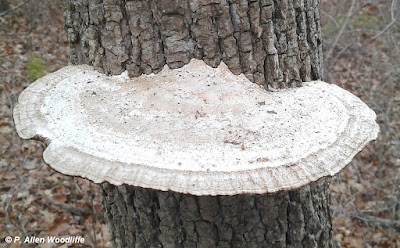Since the Christmas Bird Count season is well past, I have altered my outings a bit. Certainly a few visits to places like Rondeau Prov Park have been in order, but as the winter progresses, birds have become fewer. However there are still great reasons for getting out! I have spent some of the time just going for long walks through the forest roads and trails. Much of the time it seems I have the place to myself, which I don't mind.
I quite enjoy the incredible diversity in the shades of gray and green in winter, which can vary quite a bit depending on the direction and intensity of light. As Rondeau is an example of old growth forest, it shows how tree trunks are not always perfectly straight, as you typically see in a plantation.Yellow Birch root systems are often interesting. The seeds sprout on things like a fallen tree trunk or other root system. As they grow, they can show curious forms such as this one.
Fungi are still visible, at least the hardier ones like the bracket type of fungus shown next.
Northern Cardinals can be fairly abundant, and the males really stand out. In spite of their relative abundance now, it was just a little more than a century ago when they were first recorded breeding in Ontario, and only in the extreme southwest at Point Pelee. They certainly have expanded their range, as birds do. Now they are seen somewhat regularly well into Northern Ontario, even as far as Moosonee.
One day in my travels, I was out checking to see if a Wilson's Snipe had shown up at its usual wintering spot, in a spring fed stream southeast of Blenheim. As far as I know, it hasn't been seen by anyone there yet, but once the more intense cold arrives, along with a bit of snow, it will likely appear.
 |
| Snipe from a previous year |
I did see this Red-tailed Hawk comfortably perched on a road-side snag, looking over a few juncos and tree sparrows beneath it.
However its nervousness regarding my camera sticking out the window overcame its comfort, and off it went.I had been out to Lighthouse Cove at the mouth of the Thames River, as well as points farther west a few days ago, to cover my area for the mid-winter waterfowl survey. It was just after a recent cold snap, and the ice kept most waterfowl beyond view. In an open spot at the river mouth, I did see a few Double-crested Cormorants....
...and a Hooded Merganser.An adult Bald Eagle was perched in a tree right along the road, seemingly not bothered by traffic frequently passing almost right below. I managed a couple of photos.....
.....but as with the Red-tail, a stopped vehicle and a camera made it decide to move on.
At Jeannette's Creek where it meets the Thames River, there were about a dozen Great Blue Herons looking a little out of place.
A couple of days ago I went back out to see what was at the river's mouth. The ice had taken over almost completely, and there was only a small opening about half the size of a vehicle, where there were about 8 birds crowded in: two Canada Geese, two Common Mergansers, and four domesticated Mallard types.
I also stopped a bit upstream of the river's mouth, as there was an opening with several hundred geese. Included were 12 Snow Geese, including at least 4 blue phase........and eight Greater White-fronted Geese. We had 5 on the SCNWA CBC, and it is quite likely that they were part of this group. Most were tucked in to the larger group of geese, and difficult to photograph, but one or two were more or less out on their own.
Yesterday I was back at this spot, hoping to get some slightly crisper and overall better photos since the light on the previous trip was quite intensive, but alas, they had been seen leaving this spot a couple of hours earlier. There are still lots of geese hanging around the Chatham area and points downstream, so maybe they will turn up again.
If you would like to subscribe, or unsubscribe, to Nature Nuggets, send an email to: prairietramper@gmail.com



















No comments:
Post a Comment